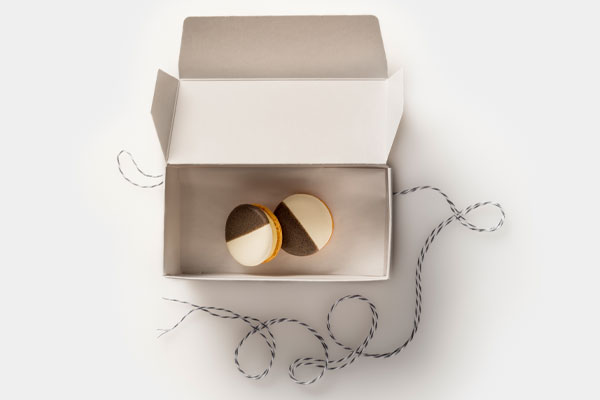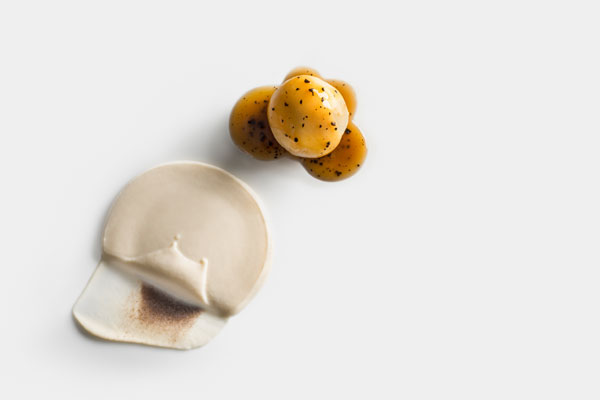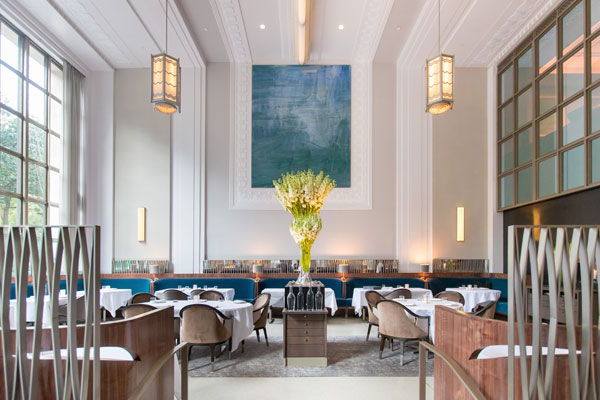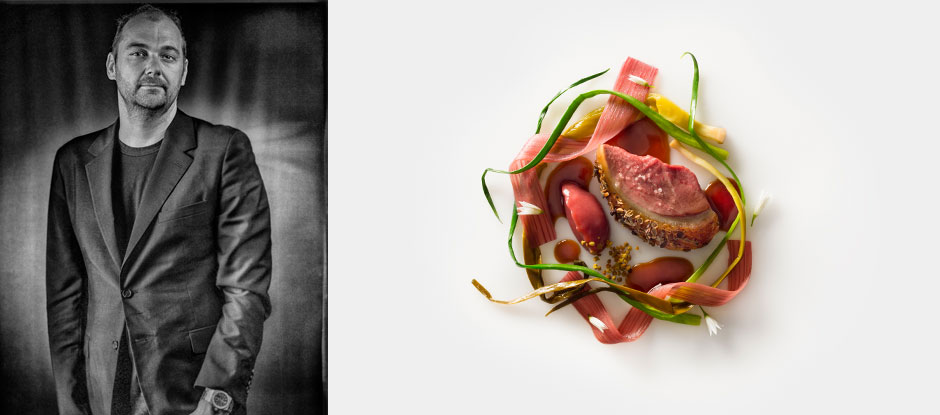Header: Daniel Humm (portrait: © Gianni Villa) and duck with rhubarb
The world’s No.1 restaurant recently reopened showcasing a freshly refined menu. In the final instalment of our Best and Beyond series, presented by Miele, we discover what drives its Swiss-born chef and co-owner Daniel Humm relentlessly forward.
In Daniel Humm’s insightful new book, Eleven Madison Park: The Next Chapter, he uses the German word ‘leidenschaft’ to help explain his approach to the profession. Broadly meaning passion, leidenschaft more literally translates as ‘suffering’. “If you are truly passionate about something, you must ask yourself if you are willing to suffer for it,” he says.
In common with others that reach the very pinnacle of their art, Swiss-born Humm is dedicated to the point of suffering. Indeed, he almost enjoys the pain of the process, tempered by the knowledge of where it can lead and that striving to do something extraordinary is not meant to be easy. He is supremely passionate not only about the craft of cooking, but also the responsibility of creating memorable, as-near-as-perfect experiences for his guests.
Meanwhile, in the foreword to the same book, Humm’s business partner and Eleven Madison Park co-owner Will Guidara writes of Humm: “Yes, he is focused and uncompromising. But he is also kind, gentle, warm, caring and openly emotional, with a smile and a laugh that lights up a room and comes through in every dish.”
The assessment from Guidara, his brother in arms for 11 years at the restaurant, is doubly revealing. First, it acknowledges Humm’s human side: he is not only driven but also empathetic and creative. At once an artist and an artisan, a perfectionist and a collaborator, just like his dishes Humm is relatively straightforward on first view, but more complex beneath the surface.
Furthermore, Guidara’s eulogising is reflective of the duo’s deep personal bond and durable business partnership. In the restaurant world, it is very rare to find an establishment run jointly by the chef and restaurateur, with their respective domains given the same weight and prominence in status and decision-making. Eleven Madison Park is famously one of those places, and has gained its status as The World’s Best Restaurant 2017 by building everything on such duality.
Watch the video interview with Daniel Humm:
Humm could surely have made it to the global elite of the cheffing world without such a union – his blend of talent and drive is truly exceptional – but then Eleven Madison Park would not be the restaurant it is. Nor would Humm be the chef he has become. “Our best work comes when we really challenge each other,” acknowledges the 41-year-old. “It is not always easy, but it has made us unstoppable.”
“Delicious food without gracious service just isn’t good enough,” said Will Guidara on stage alongside Humm at this year’s #50BestTalks event in Barcelona. “We also think that gracious service and the absence of delicious food doesn’t work either. You need to excel in the kitchen and in the dining room. The relationship between those two things – and our relationship – is truly the reason for our success, and the one that will carry us forward successfully into the future.”
Destination New York
Excelling in the kitchen is, of course, no easy task in itself. In his teenage years, Humm was an aspiring professional cyclist – a sport that demands physical and mental endurance like few others – before a combination of injury and a tough break-up led him towards conquering the kitchen instead.
His apprenticeships were in some of Switzerland’s most accomplished – and highly structured – kitchens including Baur au Lac and Gerard Rabaey’s Le Pont de Brent. “Rabaey really taught me how to cook, how to be passionate, how to be perfect,” he says. As head chef at Gasthaus zum Gupf in the Alps, where he began honing his own dishes, Humm gained his first Michelin star, aged 24. Just a couple of years later, speaking little English, he was lured to the US to oversee the kitchen at Campton Place in San Francisco, where he rapidly developed a reputation as the hottest new talent in town.
The legendary New York restaurateur Danny Meyer brought Humm over to the East Coast to be chef de cuisine at Eleven Madison Park in 2006 and soon after the partnership with Guidara was born. Immediately, they found in each other a soulmate of hospitality. Perhaps most importantly for Humm, accepting Guidara as an equal who could question his decisions helped the chef become more considered, but also less professionally self-absorbed. In 2011, the pair bought Eleven Madison Park from Meyer’s Union Square Hospitality Group with the aid of private investors, granting them full freedom to shape their own future narrative.
Over the last 11 years of Eleven Madison Park’s history, Humm’s food has itself followed an intriguing path of evolution and development. Naturally, in his early days as an immigrant to California, he fell back on his classical culinary upbringing, though always with an eye for adding new elements, fresh twists and striking presentations. By the time he arrived in New York, he had carved out a distinctive style of neoclassicism, with dishes such as his roast duck with honey and lavender beginning to become a signature.
Reservations at the grandly proportioned Art Deco dining room within Manhattan’s Met Life building became increasingly sought after. In 2009, New York Times critic Frank Bruni elevated Eleven Madison Park to its fabled ‘four-star’ status for the first time.
Then in 2010, Eleven Madison Park made its debut on The World’s 50 Best Restaurants list at… No.50. It was a moment of mixed emotion for the ambitious Humm-Guidara double act. On one hand, as Humm recalls, “we walked into a room full of our heroes, and we are blessed that over the years they have truly become our friends”. Nevertheless, the experience also fired them up, motivating them to push harder, to aim higher, and to propel their global ranking north as a result.
Black and white cookies
The pair decided to tighten the restaurant’s focus around its location, its sense of place, its New York-ness – and Humm’s menu led the way. That’s not to say he discarded hard-wired European training and techniques, more that favourite US ingredients and local food traditions were given an inventive and deluxe reworking.
Witness the introduction of dishes such as black and white cookies (still the first bite on the menu today); Long Island clam bake; carrot tartare with rye bread and condiments, and the Greensward picnic basket. At one point, the Big Apple story was delivered with arguably over-long local history lessons by the always engaged dining room team; another phase included an array of tableside theatrics and fun gimmicks. Of late, the service style has been reined in for a less scripted, more intuitive approach.
While the individual dishes and details of their delivery frequently change, Eleven Madison Park remains laser-focused on being fundamentally a New York restaurant. Humm is not a chef, or a person, prone to dramatic innovation in the mould of Ferran Adrià or Grant Achatz: he prefers endless evolution and the pursuit of perfection more akin to the likes of Thomas Keller and Alain Passard. His understated food philosophy is unlikely to redraw the culinary map as René Redzepi has done, but that does not diminish this giant of a man as a major figure in the food firmament.
Developing a culinary language
Despite having worked in professional kitchens for a quarter of a century, Daniel Humm is arguably only now coming of age as a chef. This may seem a strange assessment, because his food has long been extremely good and, unlike some of his contemporaries, Humm has ensured deliciousness is always to the fore. But to be a truly great chef, one needs to write one’s own culinary language – and Humm himself believes he is only now capable of doing that.
“I feel like only in the last two years have I found myself as a chef,” he says in his earnest, softly spoken Swiss-American drawl. He cites one particular dish – celery root with black truffles – as representing a turning point in his culinary graduation, in part because it is a dish of just two ingredients. Cooked in a pig’s bladder, the technique is complex and nuanced, but the final plating verges on the austere.
“I grew up the son of an architect. My whole life, architecture and beautiful objects have been part of my life and I have always been drawn to minimalism,” he explains. “As a chef, I wanted to cook in this sort of ‘reduced’ way, but I was never able to do it. I guess it was a lack of confidence, an insecurity, but I never felt my dishes were complete. I needed to add another garnish, another ingredient or another sauce for the dish to stand out. When I created this dish, I knew it was truly what I had been searching for.”
Celery root with black truffle
So much so that Humm now sees many of his previous dishes as being “out of place” and is reassessing his work based on four cornerstones, upon which any of his new creations must be built. These fundamentals are deliciousness, beauty, creativity and intention. While that quartet might not sound like the most radical criteria or make the snappiest of soundbites, finding the correct balance of all four in every dish is reshaping Humm’s entire approach, with outstanding results.
Humm’s plating is meticulous, as you might expect from an intense perfectionist, but also now distinctively minimalist. “For me it’s beautiful if it's minimal – if it's organic, but also if it's effortless. A few years ago I wanted the food to look like it took 20 chefs to put together, but that's not where I'm at any more.” The creative element means that every dish must have an element of surprise, a combination that is unusual – “something that really adds to the dialogue of moving food forward.”
When he says that each dish must have ‘intention’, Humm means it has to have a purpose or a story beyond the immediate. “The story could be as simple as two ingredients grown on the same farm, it could be inspired by an artist's work, it could be a childhood memory, it could be a historic dish, but somehow you need to explain why this dish exists,” he says.
Ultimately, if the food does not delight the taste buds, the chef is as dismissive as most diners would surely be. “I want my food to be beautiful, for it to be creative, for it to be intentional, but it can never be any of those if it affects how delicious the dish is. Cooking can be art, but come on, if you don’t want your food to taste good, be a painter!”
New dishes, new era
Just weeks after being named the No.1 in The World’s 50 Best Restaurants, Eleven Madison Park closed for the entire summer of 2017 to undergo an extensive front- and back-of-house remodelling. Humm and Guidara recently signed a new 20-year lease on the property and wanted to shape the restaurant for the long-term. “Success on the 50 Best list gave us the confidence to push the boundaries. Becoming number one and staying number one are two different things,” says Humm.
Eleven Madison Park's refurbished dining room (image: Gary He)
Guidara has a reshaped and refurbished restaurant in which his team can create the extra-special moments it desires for its guests. In turn, Humm oversees a freshly minted and bespoke domain that he co-designed, out of which he and his brigade are serving a pared back 8-10 course menu.
New dishes include a stunning smoked sturgeon cheesecake with caviar; a whole-roasted kabocha squash served with a bacon and seaweed broth; and a cheese course – cheddar with pretzel and beer – that invokes memories of Alpine fondues, French toast and emblematic US snacks all at the same time.
These newcomers sit alongside updated variations of some of Humm’s megahits: the by now legendary roast duck dish, savoury black and white cookies and, of course, the aforementioned celery root, albeit in a new guise. The menu feels like the ultimate expression of Humm as a chef and Eleven Madison Park as one of the outstanding restaurants of its era.
Characters such as Humm and Guidara are innately restless: Guidara was once memorably, and accurately, described by Saveur magazine as being ‘warm yet wired’; Humm, meanwhile, seeks to maintain a semblance of balance in his life through a full-on yoga and exercise program. The two of them together succeed in propelling (and supporting) each other onwards, so it’s logical that their company, Make It Nice, has been as active as its chief protagonists in recent years.
Following the success of The NoMad Hotel in New York, where the team oversees all food and drink operations including the eponymous restaurant and award-winning bar, there are two further NoMads in the offing in Los Angeles and Las Vegas. Earlier this year the company debuted its own fast-casual concept in Manhattan – under the brand Made Nice – and it has a slew of further openings, both mainstream and high-end, slated for the coming years.
However, the likelihood of this particular partnership neglecting their prize asset is as remote as Humm losing his leidenschaft. Having been named the best in the world, this new manifestation seeks to push Eleven Madison Park beyond any previous limitations. With Humm and Guidara at the helm, who knows what higher gastronomic planes it can reach?
Now watch Humm and Guidara's speech on the secrets to Eleven Madison Park's success at #50BestTalks in Barcelona:
Watch the videos and read the interviews with all seven of the chef-owners of the past and present No.1s in The World's 50 Best Restaurants as part of our Best and Beyond series, presented by Miele: Massimo Bottura, Ferran Adrià, Joan Roca, Heston Blumenthal, René Redzepi and Thomas Keller.
Stay tuned to our Facebook, Instagram and Twitter channels for alerts and subscribe to our YouTube channel for more videos.

